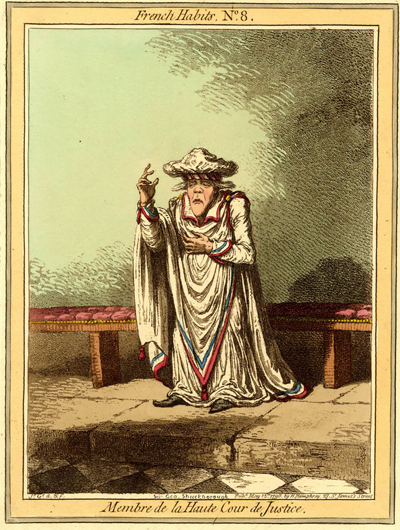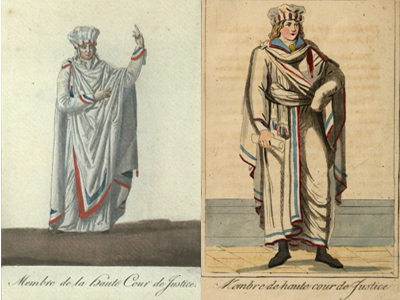French Habits: Membre de la Haute Cour de Justice
This is the eighth in a series of twelve plates in which Gillray portrays members of the Whig opposition wearing the new ceremonial robes designed by Jacques-Louis David for the prominent public officials of the French Directorate. Here Sir George Shuckburgh is shown as a member of the High Court of Justice.

© Trustees of the British Museum
The choice of Shuckburgh as a member of the High Court may have been dictated as much by Gillray's delight in caricaturing him as any other reason. As usual, Gillray bases Shuckburgh's "habit" on the French illustration of the prescribed dress: the stance and position of the hands are mirror images of that version and the floor length robe and tricolor border tending towards a "V" are picked up from that version as well. But Gillray has made that "V" more pronounced and flattened the cap in order to accentuate Shuckburgh's V-shaped jaw line and his tufts of hair jutting out horizontally just beneath his cap. That horizontal line is also picked up in the red-tufted bench behind him.

of the Robes Prescribed for a Membre de la Haute Cour de Justice [1796/97]
Otherwise, Shuckburgh is mostly an odd choice. He was not a lawyer and never a member of the Bar. And although he voted with the Whigs against the Land Tax Redemption Bill later in 1798, he was not a particularly distinguished or outspoken Member of Parliament. A fellow of the Royal Society since 1774, his passion was for mathematics and astronomy. In 1798 at the time of this print, he published An Account of Some Endeavors to Ascertain a Standard of Weight and Measure, and in the same year was a co-winner of the Copley Medal, the highest award of the Royal Society. Perhaps it was this interest in weighing and measuring that suggested to Gillray that the high court was the appropriate place to put him. But the oversized and ill-fitting robes on Shuckburgh's squat figure may also hint at his fundamental lack of suitabilty for the role. In that case, it may foreshadow Gillray's later satire on a similar discrepancy in qualifications displayed in Lilliputian-Substitutes, Equiping for Public Service (1801).
Sources and Reading
- Commentary from the British Museum on French Habits: Membre de la Haute Cour de Justice.
- "George Shuckburgh-Evelyn," Wikipedia
- Collection des nouveaux costumes des autorités constituées, civils et militaires
- Dresses of the Representatives of the People. . .
- Thomas Wright and R.H. Evans, Historical and Descriptive Account of the Caricatures of James Gillray #192
- Thomas Wright and Joseph Grego, The Works of James Gillray, the Caricaturist; With the History of His Life and Times pp. 239-240.
NEXT: French Habits 9
Comments & Corrections
NOTE: Comments and/or corrections are always appreciated. To make that easier, I have included a form below that you can use. I promise never to share any of the info provided without your express permission.